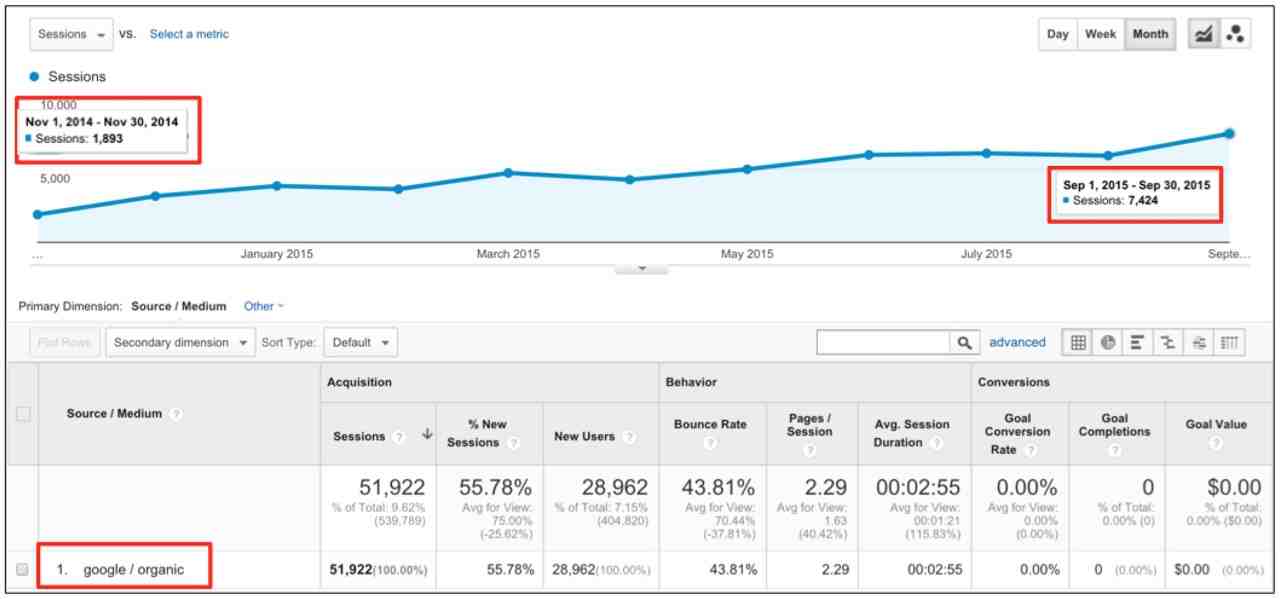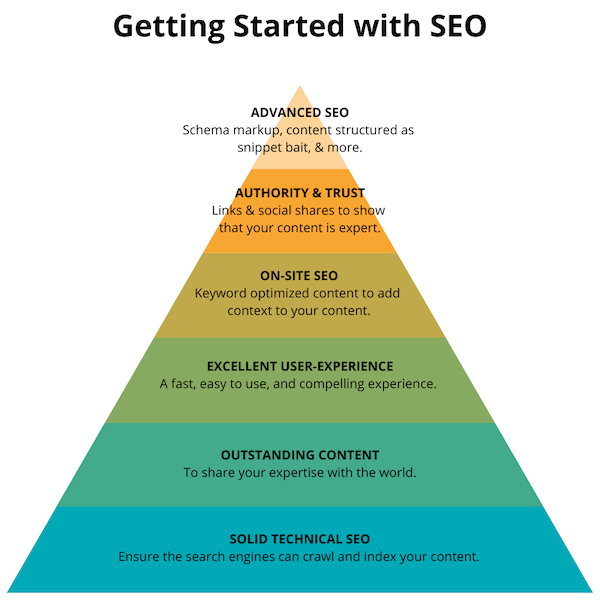Search Engine Optimization (SEO) is a marketing practice to increase organic website traffic through search engines.
It consists of techniques in four key areas: keywords and content, technical SEO, on-site SEO and off-site SEO.
These four areas are commonly considered the four pillars of SEO. Together, they help the website rank well in search engines.
While these four pillars are comprehensive, an SEO strategy is incomplete without brand awareness.
In this article, you will learn why SEO marketers should consider brand awareness as the fifth pillar of SEO.
The First Four Pillars Of SEO
Contents
- 1 The First Four Pillars Of SEO
- 2 Non-Branded Vs. Branded Searches
- 3 Why Is Branded Search Important?
- 4 Different Traffic Drivers For Non-Branded And Branded Searches
- 5 How To Grow Brand Awareness & Branded Search
- 6 Brand Awareness Is The Fifth Pillar Of SEO
- 7 What are the top 3 SEO strategies?
- 8 How many types of SEO are there?
- 9 What are the 3 pillars of SEO?
- 10 What is the single most important on page SEO factors?
- 11 What is SEO and its types?

Before looking at the fifth pillar, let’s take a look at the first four pillars of SEO:
Keyword And Content
Content rules – and keywords are the foundation of search.
A good piece of keyword-optimized content is a building block of an SEO strategy.
Technical SEO
Great content is not enough if website hosting does not have a good technical foundation.
Technical SEO covers areas such as indexability and website performance.
It ensures that the website loads its pages quickly and search engines can crawl the content easily.
In particular, Google developed a set of metrics called Core Web Vitals to measure the technical performance and usability of a website.
On-Site SEO
This pillar helps search engines understand the content of the page by creating a better structure of the website and its pages.
Site navigation hierarchy, schema markup, page titles, meta descriptions, title tags, and image alt text are tools for creating an easy-to-understand website and page structure for search engine crawlers and visitors.
Off-Site SEO
Great content and a great website is just the beginning.
A website cannot rank well in search engines if it lacks authority and trust in its subject domain.
From the very beginning, Google has used the quantity and quality of backlinks as an indicator for evaluating a website’s authority.
As far-reaching as these four areas are in creating a search-optimized website, they can only help drive a portion of your website’s search traffic, ie. the type of traffic that comes from non-branded searches.
Non-Branded Vs. Branded Searches

What are unbranded searches and how are they different from branded searches?
Branded Queries
Search terms contain brand names.
If you are Apple Inc., the search term “apple” is a trademark.
Yes, Google knows you’re looking for a company founded by Steve Jobs and Steve Wozniak, not a fetus. In addition, “iPhone”, “iPad” and “MacBook” are also trademarks.
Brand searches are done by people looking for information specifically about your brand or products.
Non-Branded Queries
On the other hand, non-branded queries do not contain any brand name in the search terms. Even for Apple Inc. “laptop”, “smartphone” and “tablet” are non-branded terms associated with its products.
Non-branded searches are from people who may not be familiar with your brand or products, but are looking for information about the type of products or solutions you offer.
When you consider this, you might think that for a brand as powerful as Apple, its search traffic mostly comes from brand searches. And for the most part, you’d be right.
Semrush says more than half of search traffic on Apple’s website comes from brand searches.
Why Is Branded Search Important?

Branded search traffic not only reflects the level of interest in a particular brand, but also has a greater commercial purpose and a higher conversion rate.
In general, unbranded search traffic feeds the top of the marketing funnel, and branded search traffic feeds the bottom of the funnel.
A brand needs to increase both types of traffic to maintain a healthy and growing business.
Image created by the author, August 2022
However, most companies do not have the level of brand recognition that Apple has.
What can marketers do to drive brand search traffic to their website?
Different Traffic Drivers For Non-Branded And Branded Searches

As shown in the formula below, search traffic is driven by two factors: keyword search volume and search engine results page (SERP) click-through rate (CTR).
A website with a high total keyword search volume and CTR will have high search traffic.
Search Traffic = Keyword Search Volume * CTR
Wait a minute! Where does keyword ranking come into the equation?
Keyword ranking is actually a key factor in determining CTR.
The higher your keywords rank, the higher your CTR.
According to the advanced online ranking, it can have the position of no. 1 on Google 38% CTR. CTR drops to around 5% at position no. 5 and remains around 1% or less after the no. 10.
Considering this, how do the four pillars of SEO contribute to a website’s search traffic?
They help a website increase search traffic in two ways:
However, the problem is that these SEO techniques only work for non-branded searches.
They have a limited effect on branded search because branded search and non-branded search have different traffic drivers.
Non-Branded Traffic Driver
In a non-branded search, a site can collect an almost unlimited amount of keywords and total search volume.
The main driver of unbranded search traffic is to improve your target keyword rankings to get a higher CTR and capture a higher share of search clicks.
Branded Traffic Driver
For brand name searches, assuming your site is already ranking first for your brand name (if not, you need to fix that first), ranking is generally not an issue.
As a brand owner, you always have priority in Google for branded keywords.
The main driver of branded search traffic is simply to increase search volume for branded keywords.
However, the first four pillars of SEO do little to get more people to search for your brand or your products.
As a result, they are ineffective in finding brands.
How To Grow Brand Awareness & Branded Search

In short, branded search traffic comes from brand recognition and interest.
People wouldn’t search for your brand if they didn’t know or care about your brand or what you offer.
To increase brand awareness and interest, you need to increase brand awareness among potential customers, develop authority, and gain brand trust.
Content marketing and growth in non-branded search traffic could help increase brand awareness.
However, relying only on people coming to your website to learn about your brand and offerings won’t get you very far.
To increase brand awareness on a large scale, marketers need to bring their brand closer to their potential customers. You can’t just wait for them to come to you.
Fortunately, there are many tools in the digital marketing arsenal to help marketers increase brand awareness, including advertising, influencer marketing, client marketing, and digital PR.
Advertising
At AdRoll, we classify advertising into two categories: retargeting and brand awareness campaigns.
As the name suggests, retargeting campaigns target people who have interacted with you (eg visited your website), while brand awareness campaigns target potential customers who have not yet interacted with you.
Marketers can choose from several targeting methods to get your brand in front of potential customers.
Contextual Targeting
Contextual targeting is one of the oldest methods of targeting advertising.
Think of a hotel chain that advertises in a travel magazine. A brand may publish advertisements on websites or mobile applications with content relevant to its products or services.
A big difference between contextual targeting and other targeting methods is that contextual targeting does not rely on personal or behavioral data about the target audience.
It’s a more privacy-friendly way for marketers to find and connect with their potential customers.
With regulators and tech companies looking for ways to improve consumer privacy protections, the importance of contextual targeting to advertisers is likely to increase.
Demographic And Interest Targeting
Demographic and interest targeting leverages your knowledge of existing customers to find new customers.
Let’s say your customers fall into a certain demographic segment or are interested in certain activities or topics. In this case, you can bring your brand closer to potential customers by showing ads that target people with similar demographics or interests.
Lookalike Targeting
Lookalike targeting is similar to demographic and interest targeting.
But instead of manually defining a target audience segment based on a list of demographic or interest attributes – advertising platforms use machine learning technologies to find target audiences that look or behave similarly to the initial audience provided by marketers.
The initial audience is usually a subset of existing customers.
Influencer Marketing
Influencer marketing covers a wide range of tactics to get someone who influences your target customers to promote your brand and products.
Even before the digital age, it was common for big brands to hire famous athletes or celebrities to endorse their products. Think Michael Jordan and Nike in the 80s.
Today, “influencers” are social media personalities who have built a following with a specific audience.
The sheer number of social media influencers also means that influencer marketing is no longer a privilege available only to those brands with deep pockets.
Marketers can recruit influencers at very little or no cost by reaching out to those who have shown interest or are already invested in the niche you serve, including your customers (more on this in the next section).
While a lot of influencer marketing is in the B2C sector, it also works for B2B.
Customer Marketing
When shopping on an e-commerce marketplace like Amazon, you can view product reviews before making a purchase decision.
The number and rating of a product’s reviews are also ranking factors when searching for products on Amazon.com.
The more people rate the product and the higher the rating, the more visibility and traffic the product gets.
The same logic applies even if Amazon might not be the channel for your business.
For B2B SaaS providers, they have customer reviews on G2, Trustpilot, etc. the same role.
For direct-to-consumer (D2C) brands, customer reviews and social sharing bring your brand and products to new customers and help build trust in your brand.
Take Halfbikes.com as an example.
This D2C company from Bulgaria has a team of brand ambassadors – their customers – around the world who promote their brand and product simply by sharing their experiences on social media.
Some of their customers have even created YouTube channels dedicated to Halfbikes.
Digital PR
Of all the strategies that promote brand awareness, digital PR is the one most directly related to SEO. In fact, it’s often considered “link building 2.0.”
The main difference between link building and digital PR is that link building focuses on getting links from other websites.
In contrast, digital PR focuses on bringing your brand closer to your target audience through stories published in relevant, high-quality publications.
Story types vary by industry and subject.
Change your Facebook name to Meta. In this context, for example, the topic of how consumers perceive the metaverse could be an interesting story for B2C marketers.
Since well-known publications tend to have very strict link policies, digital PR prioritizes brand awareness and reach, while getting links is a secondary goal.
Brand Awareness Is The Fifth Pillar Of SEO
One of the goals of a comprehensive marketing strategy should be to increase brand awareness – just as a comprehensive SEO strategy should aim to increase non-branded and branded searches.
While non-branded search traffic drives keyword rankings, branded search traffic mostly drives branded keyword search volume.
The more people are familiar with and interested in the brand, the more search traffic the brand receives.
Given the different factors behind the growth of branded and non-branded searches, SEO professionals must incorporate brand awareness as a pillar of SEO.
Featured image: batjacket/Shutterstock
What are the top 3 SEO strategies?
What are the top three SEO strategies?
- #1 Website Optimization. Let’s start with what you already have: your website. …
- #2 Post content regularly. SEO traffic also depends on the consistency in which you post your blogs. …
- #3 Link building. …
- Take the uncertainty out of content marketing with DemandJump.
How many types of SEO are there?
There are about 12 different types of SEO that help websites rank better on search engine results pages.
What are the 3 types of SEO? There are three main types of SEO: internal (on-page SEO) external (off-page SEO) technical SEO.
What are the 3 pillars of SEO?
Instead, SEO is supported by three different pillars: discoverability, relevance, and authority. Make sure your website follows these three SEO concepts for the future and you’ll have a content marketing strategy that will increase your position on the search engine results pages (SERPs).
What is the single most important on page SEO factors?
The most important on-page SEO factor for overall ranking potential: Domain Authority. Domain Authority or DA is a score ranging from 1 to 100.
What is undoubtedly the most important factor in SEO? 1. Publish high-quality content. “I don’t need quality content to rank on my site,” said no one. The quality of your website and blog content is still crucial.
What are the most the most important on page SEO elements?
In conclusion, the most important on-page SEO factors include well-written and original content, good title and description tags, formatting with proper use of title and sub-headings, use of images and their descriptions, and well-constructed URLs. that contain the most important keyword and are not too long.
What is off-page SEO beginner?
Off-page SEO is the process of optimizing your web pages outside of your website by getting links back to it, because the only thing you can do outside of your website is to link back to it. These backlinks act as a vote for your blog content.
How important is off-page SEO?
Off-page SEO helps build website visibility and domain authority. Without it, your site will constantly rank below other sites that already have a higher priority. While links aren’t the only off-page signals Google’s algorithm uses to rank a website, they’re perhaps the most important of all.
What is the importance of on page SEO?
On-page SEO helps search engines analyze your website and related content so that it can determine whether the searcher’s query is relevant to your website. Google is constantly updating its algorithm so that it can better understand a searcher’s intent and provide search results that meet that user’s needs.
Quels sont les 5 piliers du SEO ?
Il s’agit de la structure, les templates de pages, le contenu éditorial present sur les differentes pages, la notoriété ainsi que l’expérience utilisateur.
Quel est le SEO ?
Le SEO (Search Engine Optimization) is an acronym that means “Search Engine Optimization” in French. It’s an ensemble of techniques allowing to position a web site in search engines to make it visible to the Internet.
What is SEO and its types?
The term SEO, search engine optimization, refers to improving the visibility of your website in Google search results for relevant keywords or search phrases. SEO helps in generating traffic to the website naturally.
What do you mean by SEO? Search engine optimization is the science of improving a website to increase its visibility when people search for products or services. The more visible a website is in search engines, the more likely a brand is to win business.
